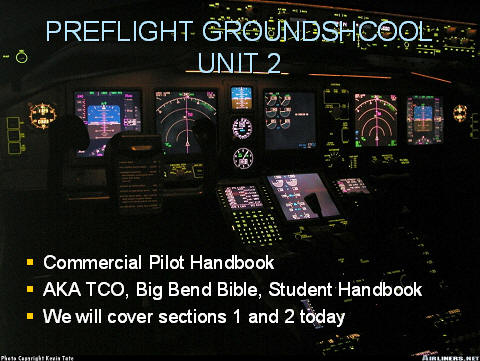Preflight Ground School Unit 2
PREFLIGHT GROUNDSHCOOL UNIT 2
Da Rules Folks
Flight records must stay on the flight line at all times
No smoking
No multiples
Tower in number 1 BBCC in number 2
You may open the door next to you on hot days
If you want to take a friend up they must sign a Hold Harmless Agreement and the flight must be dual
You may not give rides to anyone solo
Lean only on x-country flights
Use the brakes only for stopping
You must remain at 2000 msl when departing east
Other Important Big Bend Rules
Student records are Big Bend Property.
You may not fly solo to Moses Lake Municipal airport, that goes for Quincy as well.
You may not fly solo to Ephrata unless specifically endorsed to do so.
You may not smoke in Big Bend aircraft.
You will not be required to memorize the checklists.
Tomato Flames
T-Tachometer
O-Oil Pressure
M-Manifold Pressure
A-Altimeter
T-Temp for liquid cooled engines
O-Oil Temp
F-Fuel gauges
L-Landing gear indicator lights
A-Airspeed indicator
M-Magnetic Compass
E-ELT (Emergency Locator Transmitter)
S-Seat Belt and Shoulder Harness
Eye Mechanics
The retina is a light-sensitive layer at the back of the eye that covers about 65 percent of its interior surface.
Photosensitive cells called rods and cones in the retina convert incident light energy into signals that are carried to the brain by the optic nerve.
A person has about 120 million rods and 6 to 7 million cones
In the middle of the retina is a small dimple called the fovea or fovea centralis.
It is the center of the eye’s sharpest vision and the location of most color perception.
Vision in Flight
Scanning
As mentioned, our best vision is obtained in a very small area of the eye known as the Fovea.
In order to spot aircraft at a distance, it is necessary to “see” that aircraft with your Fovea.
In order to do that, we use a special technique to help us spot enemy aircraft at greater distances.
Break the area into 10 degree increments, scanning each increment in 1 to 2 seconds.
Start your scan at the instrument panel then the wingtip and then a point 5 miles out
This will help minimize eye fatigue and provide a structured setting.
Vision in Flight
Scan from left to right, pausing about half way to rescan the instrument panel.
The ratio of inside to outside time should be about 4 seconds inside to 16 seconds outside.
Move the aircraft nose out of the way using a series of 5 degree bank clearing turns on the climb out.
Keep your head moving so door posts and such don’t block your vision.
Collision Avoidance
Relative Altitude
Right of Way Rules
Multiple Threats
Collision Course Targets
High Hazard Areas
Cockpit Management
Windshield Conditions
Visibility Conditions
Obstructions in the Cockpit
Operation “Lights On”
ATC Services


